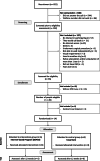Foot-ankle functional outcomes of using the Diabetic Foot Guidance System (SOPeD) for people with diabetic neuropathy: a feasibility study for the single-blind randomized controlled FOotCAre (FOCA) trial I
- PMID: 33766146
- PMCID: PMC7995736
- DOI: 10.1186/s40814-021-00826-y
Foot-ankle functional outcomes of using the Diabetic Foot Guidance System (SOPeD) for people with diabetic neuropathy: a feasibility study for the single-blind randomized controlled FOotCAre (FOCA) trial I
Abstract
Background: Diabetic neuropathy dramatically affects musculoskeletal structure and function of the lower limbs by impairing their muscle strength and mobility. Specific muscle strengthening through physiotherapy strategies appears to be promising; however, adherence to physiotherapy treatment is low in people with chronic diseases. Thus, an internet-based foot-ankle exercise program was created as a potential telerehabilitation alternative for people with diabetes to improve their self-monitoring and self-care management. This study assessed the feasibility, safety, acceptability, and changes in foot health and neuropathy symptoms in people with diabetes after 12 weeks of the intervention program with the Sistema de Orientação ao Pé diabético - Diabetic Foot Guidance System (SOPeD).
Methods: Fourteen individuals were recruited and randomized to either the usual care (control group) or usual care plus an internet-based foot-ankle exercise program through SOPeD (intervention group) three times per week for 12 weeks. For feasibility, we assessed contact and recruitment rates per week; program adherence, determined as completing over 70% of the 36 sessions; and participant satisfaction and safety assessed through a questionnaire and scored on a 5-point Likert scale. We assessed changes in neuropathy symptoms and foot health and functionality from baseline to 12 weeks estimating differences or median of differences and 95% confidence intervals in the intervention group.
Results: In 24 weeks, of the 822 patients in the database, 192 were contacted, 65 were assessed for eligibility, and 20 were considered eligible. The recruitment rate was 0.83 participants per week. Fourteen out of the 20 eligible participants agreed to participate, resulting in recruitment success of 70%. Adherence to the program was 66.7%, and there was no dropout. Participants' median level of satisfaction was 5.0 (IQR: 4.5-5.0) and perceived safety was 5.0 (IQR: 5.0-5.0).
Conclusion: The internet-based foot-ankle exercise program using SOPeD is feasible, satisfactory, and safe. Although this study had moderate adherence and a zero-dropout rate, recruitment needs to be improved in the larger trial.
Trial registration: ClinicalTrials.gov, NCT04011267 . Registered on 8 July 2019.
Keywords: Diabetic neuropathy; Feasibility study; Foot-related exercises; Musculoskeletal function; Preventive care; Rehabilitation technology; Self-management; eHealth.
Conflict of interest statement
The authors declare that they have no competing interests.
Figures





Similar articles
-
Effectiveness of a web-based foot-ankle exercise program for treating ulcer risk factors in diabetic neuropathy in a randomized controlled trial.Sci Rep. 2024 Nov 8;14(1):27291. doi: 10.1038/s41598-024-78188-7. Sci Rep. 2024. PMID: 39516524 Free PMC article. Clinical Trial.
-
Could an Internet-Based Foot-Ankle Therapeutic Exercise Program Modify Clinical Outcomes and Gait Biomechanics in People with Diabetic Neuropathy? A Clinical Proof-of-Concept Study.Sensors (Basel). 2022 Dec 7;22(24):9582. doi: 10.3390/s22249582. Sensors (Basel). 2022. PMID: 36559949 Free PMC article. Clinical Trial.
-
Study protocol for a randomized controlled trial on the effect of the Diabetic Foot Guidance System (SOPeD) for the prevention and treatment of foot musculoskeletal dysfunctions in people with diabetic neuropathy: the FOotCAre (FOCA) trial I.Trials. 2020 Jan 13;21(1):73. doi: 10.1186/s13063-019-4017-9. Trials. 2020. PMID: 31931855 Free PMC article.
-
Feasibility of a home-based foot-ankle exercise programme for musculoskeletal dysfunctions in people with diabetes: randomised controlled FOotCAre (FOCA) Trial II.Sci Rep. 2021 Jun 11;11(1):12404. doi: 10.1038/s41598-021-91901-0. Sci Rep. 2021. PMID: 34117342 Free PMC article. Clinical Trial.
-
Effect of three-week exercise program on muscle strength and joint mobility in patients with diabetic polyneuropathy: Randomized controlled trial.World J Diabetes. 2024 Dec 15;15(12):2311-2321. doi: 10.4239/wjd.v15.i12.2311. World J Diabetes. 2024. PMID: 39676803 Free PMC article. Review.
Cited by
-
Affordable web-based foot-ankle exercise program proves effective for diabetic foot care in a randomized controlled trial with economic evaluation.Sci Rep. 2024 Jul 12;14(1):16094. doi: 10.1038/s41598-024-67176-6. Sci Rep. 2024. PMID: 38997439 Free PMC article. Clinical Trial.
-
Effectiveness of a web-based foot-ankle exercise program for treating ulcer risk factors in diabetic neuropathy in a randomized controlled trial.Sci Rep. 2024 Nov 8;14(1):27291. doi: 10.1038/s41598-024-78188-7. Sci Rep. 2024. PMID: 39516524 Free PMC article. Clinical Trial.
-
Could an Internet-Based Foot-Ankle Therapeutic Exercise Program Modify Clinical Outcomes and Gait Biomechanics in People with Diabetic Neuropathy? A Clinical Proof-of-Concept Study.Sensors (Basel). 2022 Dec 7;22(24):9582. doi: 10.3390/s22249582. Sensors (Basel). 2022. PMID: 36559949 Free PMC article. Clinical Trial.
References
Associated data
Grants and funding
- 28/2018 FOCA Trial 407252/2018-5/Conselho Nacional de Desenvolvimento Científico e Tecnológico
- 119178/2019/Conselho Nacional de Desenvolvimento Científico e Tecnológico
- 304124/2018-4/Conselho Nacional de Desenvolvimento Científico e Tecnológico
- Financial Code 001/Coordenação de Aperfeiçoamento de Pessoal de Nível Superior
- Financial Code 001/Coordenação de Aperfeiçoamento de Pessoal de Nível Superior
LinkOut - more resources
Full Text Sources
Other Literature Sources
Medical

